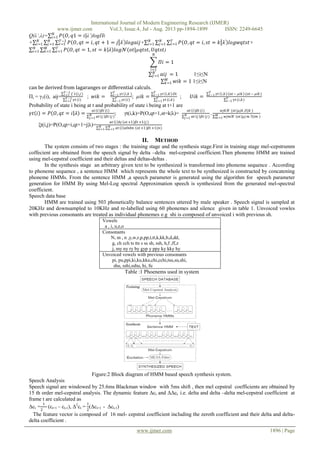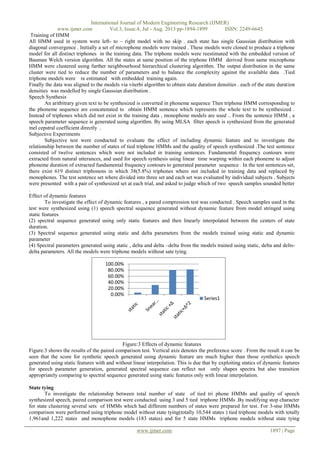This paper presents a text-to-speech synthesis approach using Hidden Markov Models (HMMs), where speech parameters are generated through a maximum likelihood criterion. The effectiveness of this method is demonstrated through subjective experiments highlighting the importance of dynamic features in synthesizing natural-sounding speech. Additionally, the study details the training processes and algorithms employed for efficient speech synthesis from phonetic sequences.
![International Journal of Modern Engineering Research (IJMER)
www.ijmer.com Vol.3, Issue.4, Jul - Aug. 2013 pp-1894-1899 ISSN: 2249-6645
www.ijmer.com 1894 | Page
Smita Chopde#
, Pushpa U. S.*
#
EXTC Dept. Mumbai University, Mumbai
Abstract: This paper describes a approach to text-to-speech synthesis (TTS) based on HMM. In the proposing approach,
speech spectral parameter sequences are generated from HMMs directly based on maximum likelihood criterion. By
considering relationship between static and dynamic features during parameter generation, smooth spectral sequences are
generated according to the statistics of static and dynamic parameters modelled by HMMs, resulting in natural sounding
speech. In this paper, first, the algorithm for parameter generation is derived, and then the basic structure of an HMM based
TTS system is described. Results of subjective experiments show the effectiveness of dynamic feature.
Keywords: Include at least 5 keywords or phrases
I. INTRODUCTION
A Hidden Markov Model (HMM) is finite state machine which generates a sequence of discrete time observation.
At each time unit (frame) the HMM changes state according to state transition probability distribution, and then generates an
observation ot at time t according to output probability distribution of the current state .Hence the HMM is doubly stochastic
random process model.
An N state HMM is defined by state transition probability distribution A= 𝑎𝑖𝑗 𝑁 𝑖, 𝑗 = 0and output probability
B={bj(o)}N
j=0 and initial state probability distribution π= {πi}N
i=0 . For convenience the compact notation.
λ =(A,B,π)
Figure 1. Examples of HMM parameter is used to indicate parameter set of the model
Figure 1 shows the HMM model Figure 1 (a) shows the 3 state ergodic state ,in every state of model could be
reached from every other state of the model in single step figure 1(b) shows the a 3 state left to right model in which the
state index increases or stays same as time increase. Generally left to right HMMs are used to model speech parameter
sequence since they can appropriate model signal whose property changes in successive manner. The output probability
distribution bj(ot) can be discrete or continuous depending on the observation. Usually in continuous distribution HMM
(CDHMM) an output probability distribution is modelled by mixture of multivariate Gaussian distribution which as follows
M
bj(o)= ∑wjmN(o|µjm,,Ujm)
m=1
Where M= number of mixture component wjm, μjm, Ujm are weight, a mean vector, and covariance matrix component m
of state j, respectively. A Gaussian distribution N (o|µjm,,Ujm) is defined by
N(o|µjm,,Ujm) = ( 1/( 2𝜋 )d
|𝑈|) exp(−1/2(𝑜 − µµjm)Τ
Ujm
-1
(o - µjm)
Where d is dimensionality of o. mixture weight wjm satisfies the stochastic constraint
∑wjm =1 1≤ j≤ N
Wjm ≥ 0 1≤ j≤ N, 1≤ m ≤ M
So that bj(o) are properly normalized .
ᶋ 𝑏𝑗 𝑜 𝑑𝑜 = 1 1≤ j≤ N
When the observation vector o is divided into S independent data stream i.e. o = [o1
Τ
,o2
Τ
, o3
Τ
,....................oS
Τ
]Τ
bj(o) is
formulated by product of Gaussian mixture densities.
S
bj(o)=Π bjs(os)
s=1
HMM-Based Speech Synthesis](https://image.slidesharecdn.com/af3418941899-130912023526-phpapp01/85/HMM-Based-Speech-Synthesis-1-320.jpg)
![International Journal of Modern Engineering Research (IJMER)
www.ijmer.com Vol.3, Issue.4, Jul - Aug. 2013 pp-1894-1899 ISSN: 2249-6645
www.ijmer.com 1895 | Page
S Ms
bj(o)= Π{ΠwjsmN(os|µjsm,Ujsm )}
s=1 m=1
Likelihood calculation
When the state sequence is determined as Q= (q1 q2 q3 q 4….qT ), the likelihood of generating an observation sequence
O=(o1, o2, o3, o4,….oT) is calculated by multiplying the state transition probabilities and output probabilities for each state
𝑃 𝑂,
𝑄
𝜆
= 𝑨𝒒𝒕 − 𝟏, 𝑨𝒒𝒕, 𝑩𝒒𝒕, 𝑶 𝒕
𝑻
𝒕=𝟏
Where Aq0j denote πj. The likelihood of generating O from HMM 𝞴 is calculated by summing P(O,Q/𝞴) for all possible
sequences
𝑃
𝑜
𝞴
= 𝑨𝒒𝒕 − 𝟏, 𝑨𝒒𝒕, 𝑩𝒒𝒕, 𝑶(𝒕)
𝑻
𝒕=𝟏𝑸𝒂𝒍𝒍
The likelihood of above equation is sufficiently calculated using forward and/or backward procedure .
The forward and backward variables are
αt(i)=P(o1,o2,...........oT,qt=i/λ)
βt(i)=P(ot+1 ,ot+2, ...................oT,q=i,λ)
can be calculated individually as
1. Initialization
α1(i)=Π bi(o1) 1<i<N
βT (i) = 1 1<i<N`
2. Recursion
αT+1(i)= αt (j)aji𝑁
𝑗=1 𝑏i(t+1) 1 <i<N
t=2,.....................T
3. Termination
P* =max[(δT(i) ]
q*=argmax[(δT(i) ]
4. Path back tracking
qt
*
= Ψt+1(q*
t+1)
Maximum Likelihood Estimation of HMM parameter
There is no known method to analytically obtain the model parameter set based on maximum likelihood based on
maximum likelihood (ML) criterion ., that is to obtain which maximises likelihood P(O/λ) for a given observation
sequence O , in a closed form. Since this problem is a high dimensional nonlinear optimization problem, and there will be
number of local maxima . , it is difficult to obtain λ which globally maximizes P(O/λ) and can be obtained using an
iterative procedure such as the expectation –maximization (EM) algorithm ( which is often referred to as Baum-Weich
algorithm), and the obtained parameter set will be a good estimate if a good initial estimate is provided .
In the following , the EM algorithm for the CD-HMM are described . The algorithm for the HMM with discrete output
distribution can also be derived in the straight forward manner
Q-Function
In the E M algorithm , an auxiliary function Q(λ’,λ) of current parameter set λ’ and new parameter set λ is defined
as follows
Q(λ’,λ)=
1
𝑃(
𝑂
𝜆
)
𝑃 𝑂, 𝑄 𝜆′
logP(O, Qλ).
Here , each mixture component is decomposed into a substrate and Q is redefined as a substrate sequence i.e.
Q=((q1 ,s1) ,(q2 ,s2 ), ......................(qT,sT)
Where (qT,sT) represents the being substrate st of state qt at time t.
At each iteration of procedure current parameter set λ’ is replace by new parameter set which maximises Q(λ’,λ).
This iterative procedure can be provided to increase likelihood P(O|λ) monotonically and converge to a certain critical
point since it can provide that Q- function satisfies the following theorem
Theorem 1
Q(λ’,λ)≥ Q(λ’,λ’) i.e. P(O|λ)≥P(O|λ’)
Theorem 2
The auxiliary function Q(λ’,λ) has a unique global maximum as a function of λ and this is the one and the critical point.
Theorem 3
A parameter set λ is the critical point of the likelihood P(O|λ) if and only if it is a critical point of the Q- function.
Maximization of the Q-Function
logP(O, O|λ) can be written as
logP(O, O|λ)= 𝑎𝑞𝑡 − 1𝑞𝑡𝑇
𝑡=1 + 𝑤𝑞𝑡𝑠𝑡𝑇
𝑡=1 + log(𝒩 (𝑜𝑡|µ𝑞𝑡 𝑠𝑡,Uqt st),
where aq0q1 denotes Πq1. Hence the Q function can be written as](https://image.slidesharecdn.com/af3418941899-130912023526-phpapp01/85/HMM-Based-Speech-Synthesis-2-320.jpg)



![International Journal of Modern Engineering Research (IJMER)
www.ijmer.com Vol.3, Issue.4, Jul - Aug. 2013 pp-1894-1899 ISSN: 2249-6645
www.ijmer.com 1899 | Page
Figure: 5 Comparison of 3-state and 5- state HMMs
Along x-axis
1 3-state HMM (1961 states)
2 3-state HMM (1222 states)
3 5-state HMM (2040 states)
4 5-state HMM (1199 states)
From the above figure it can be seen that scores for 3-state and 5-state models were almost equivalent when number of
states were almost 2000, the score of 5-state models was better when the number states were 1200. When the total number
of tied states were almost the same , 5- sate model has higher resolution in time than 3- sate model reversely, 3-sate model
has better resolution in parameter space than 5-state model .From the result if total number of state state is limited, models
with higher resolution in time can synthesize more naturally sounding speech than model with higher parameter resolution
in space .
III. CONCLUSION
In parameter generation algorithm a speech generation sequence is obtained so that likelyhood of HMM for
generated parameter sequence is maximized. By exploiting the constraints between static and dynamic features the
generated parameter sequence results not only for static of shapes of spectra but also transition obtained from training data
appropriately, resulting in smooth and realistic spectral sequence .In parameter generation algorithm a problem of
generating parameter speech was simplified assuming that parameter sequence was generated along single path. The
extended parameter algorithm using multi-mixture HMMs model has more ability to generate natural soundings speech,
however extended algorithm has more computational complexity since it is based on expectation- maximization algorithm
,which results in iteration of forward –backward algorithm and parameter generation algorithm.
References
[1]. R . E. Donowan and E.M.Eide,”The IBM Trainable Speech Synthesis System,” Proc . ICSLP-98 , 5,pp,1703 1706 , Dec 1998.
[2]. F.A.Falaschi ,M. Giustiniani and M. Verola , “ A Hidden Markov Model approach to speech synthesis , “ Proc. EUROSPEECH-89,
pp.187-190.sep.1989.
[3]. A. Gustiniani and P.Pierucci, “Phonetic ergodic HMM for speech synthesis,” Proc.EUROSPEECH-91,pp.349-352,sep1991.
[4]. M. Tonomura, T.Kosakaand S. Matsunaga, “Speaker adaptation based on transfer vector field smoothing using maximum a posterior
probability estimation,” Computer speech and Language , vol.10.n0.2pp.117-132,Apr.1996.
0
0.1
0.2
0.3
0.4
0.5
0.6
0.7
1 2 3 4 5 6](https://image.slidesharecdn.com/af3418941899-130912023526-phpapp01/85/HMM-Based-Speech-Synthesis-6-320.jpg)